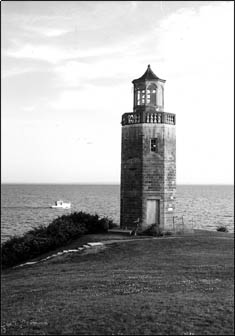Historic
Information
The Avery Point
Lighthouse
The Avery Point
Lighthouse is situated at the southeastern end of the University of
Connecticut’s Avery Point campus located off of Shennecossett Road in the
Town of Groton.
The Avery Point campus was originally the site of the 72-acre estate of
Morton F. Plant, a wealthy industrialist, philanthropist and yachtsman,
who was very influential in local development in the early 1900’s.
Several large and ornate granite structures were constructed and completed
on this site prior to 1903. One well-known structure, which still stands
today, is called the “Branford House” and is listed on the National
Historic Register. The upper of this building presently houses university
administrative offices and the lower floor is made available for special
meetings and banquets.
In 1938, some two decades after the death of Morton Plant, his estate was
sold, at auction, to the State of Connecticut.
In March of 1942, the property was sold by the State of Connecticut to the
United States Government. The Quit Claim Deed for this transaction
stipulated that the “United States of America [will] erect and maintain on
or over the land . . . . beacon lights or other buildings and apparatus to
be used in aid of navigation”. The Deed further required that the lights,
buildings and apparatus be constructed within five years.
In 1942 the United States Coast Guard (USCG) occupied the site and
established the USCG Training Station. Throughout the years, thousands
of Coast Guardsmen received training at the Groton Station in a variety of
schools, including radio communications and aids to navigation – the
latter being established in 1945.
In March of 1943, the USCG fulfilled the requirement of the Quit Claim
Deed and completed the construction of Avery Point Lighthouse. It was at
this time considered “ready for service”; however, World War II
“hostilities concerns” precluded the light from being lit until May 2,
1944.
The fifty-five foot octagonal-shaped structure has two internal levels
including the upper level lantern room and a walk - around outer deck.
The bearing walls are constructed of unusual block masonry units (blocks)
made of a brown colored cement and sand. Three different size blocks were
used in constructing the walls.
The wooden lantern room is set back and forms a ‘walk-around’ between its
exterior and the top of the masonry tower. This lantern room is hand
carved and has hints of Williamsburg architecture. It has eight
separate fixed glass lower window panes and Palladian glass upper frames.
A three-foot high balustrade travels around the top of the structure and
is perhaps the most unique architectural feature of the lighthouse. It
consists of brown colored cast stone rails and corner posts located at the
intersection of the octagon’s eight sides. Between the rails of the
balustrade are thirty-two equally spaced turned pink Italian marble
balusters. These balusters once adorned the famous flower gardens of
Morton Plant.
Overall, the lighthouse takes on the look of a ‘tower’ rather than a
traditional lighthouse.
According to a description in Kenneth Kochel’s 1994 edition of “America’s
Atlantic Coast Lighthouses: A Traveler’s Guide”, the Avery Point
Lighthouse “. . . . was built to be a memorial tower . . . . and a
symbolic representation of the Coast Guard’s lighthouse keeping
responsibilities”. It was the last lighthouse constructed in the State of
Connecticut.
Some have stated that the structure was never an actual “aid to
navigation”; however, independent research by the Avery Point Lighthouse
Society has proven otherwise. The lighthouse is listed in the USCG’s
[navigational] List of Lights from 1944 through 1967. The light, and it
characteristics, also appear on numerous USCG approved maritime
navigational aid charts. Initially the beacon of the lighthouse was a
cluster of eight fixed lights; however, in March of 1960 the
characteristic was changed to flashing green every four seconds. The
change of light pattern is listed in the USCG’s [navigational] “Notice to
Mariners”.
In 1967, the Coast Guard closed its training center at Avery Point and
relocated to Governor’s Island, New York. The Avery Point property was
again occupied by the State of Connecticut.
The University of Connecticut, established an off-site campus at Avery
Point shortly after the departure of the Coast Guard. The Coast Guard
maintains a small staff at a research and development type laboratory at
Avery Point and had periodically used the lighthouse to conduct various
navigation experiments.
Unfortunately, for a period of over thirty years, maintenance and upkeep
of the lighthouse was sorely lacking and largely discontinued. The
structure developed serious deterioration problems and, in 1997, the
University considered razing the structure.
A group of local citizens, calling themselves the Avery Point Lighthouse
Society (APLS), organized an effort to Save, Restore and Relight the
structure. APLS, which subsequently became a chapter of the American
Lighthouse Society of Wells, Maine, was successful in saving the structure
from the wrecking ball and in raising substantial funds to restore the
structure to its original glory. The organization was also successful in
having the lighthouse placed on the National Register of Historic Places.
|
Structural restoration of the lighthouse was completed in November, 2005.
A dedication brick walkway, traveling a distance of over 840 feet and
consisting of over 3,100 engraved and 17,000 blank bricks was installed at
the site of the lighthouse and completed in the spring of 2006.
APLS, ALF and the University are presently working together to receive
permission from the United States Coast Guard to install a light in the
lighthouse so it once again will be used as an official aid to
navigation. It is anticipated this process will move along very smoothly
and that the light will be installed in time for a relighting/rededication
ceremony for the lighthouse scheduled for October 15, 2006. |
